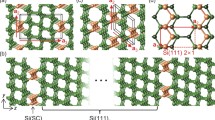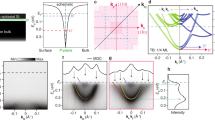Abstract
The use of ultrathin crystalline silicon (c-Si) wafers in solar cells necessitates a highly effective light absorber to compensate for poor light absorption. One route to overcoming this problem is to use a periodic array of Si nanodisks on ultrathin c-Si. In the present manuscript, we numerically investigate the effects of the geometrical parameters of the Si nanodisks, including disk diameter (D) and length (L), on the structural and optical properties, using atomistic tight-binding theory. These computations confirm that the electronic structure and optical properties are sensitive to the structural parameters. As the disk diameter and length increase, the single-electron energies decrease, and the single-hole energies increase. These calculations also reveal that, because of the quantum confinement effect, the optical band gaps gradually decrease independently of the increasing disk diameter and length. The optical spectra can be tuned across the visible region by varying the disk diameter and length, which is a useful feature for optimizing light absorption in solar cell applications. As the disk diameter and length increased, the optical intensities also increased; however, the atomistic electron–hole interactions and ground electron–hole wave function overlap progressively decreased. The ground electron–hole wave function overlap, Stokes shift, and fine structure splitting decreased as the disk diameter and length were increased. Thus, Si nanodisks with a large diameter and length might be a suitable candidate source of entangled photons. The Si nanodisks in this study also show promise for applications to solar cells based on ultrathin c-Si wafers.
Similar content being viewed by others
References
H.A. Atwater and A. Polman, Nat. Mater. 9, 205 (2010).
S.M. Nie and S.R. Emery, Science 275, 1102 (1997).
P.J. Tarcha, J. DeSaja-Gonzalez, S. Rodriguez-Llorente, and R. Aroca, Appl. Spectrosc. 53, 43 (1999).
N. Engheta, Science 317, 1698 (2007).
I. Kim, D.S. Jeong, W.S. Lee, W.M. Kim, T.-S. Lee, D.-K. Lee, J.-H. Song, J.-K. Kim, and K.-S. Lee, Opt. Express 22, A1431 (2014).
M.F. Budiman, W. Hu, M. Igarashi, R. Tsukamoto, T. Isoda, K.M. Itoh, I. Yamashita, A. Murayama, Y. Okada, and S. Samukawa, Nanotechnology 23, 065302 (2012).
T. Kiba, Y. Mizushima, M. Igarashi, S. Samukawa, and A. Murayama, Nanoscale Res. Lett. 7, 587 (2012).
T. Kiba, Y. Mizushima, M. Igarashi, C.-H. Huang, S. Samukawa, and A. Murayama, Appl. Phys. Lett. 100, 053117 (2012).
S.-C. Yang, K. Richter, and W.-J. Fischer, Appl. Phys. Lett. 106, 081112 (2015).
T. Shibanuma, P. Albella, and S.A. Maier, Nanoscale 8, 14184 (2016).
J. Valenta, B. Bruhn, and J. Linnros, Nano Lett. 11, 3003 (2011).
Q. Wu, X.-H. Wang, T.A. Niehaus, and R.-Q. Zhang, J. Phys. Chem. C 118, 20070 (2014).
Y. Wang, R. Zhang, T. Frauenheim, and T.A. Niehaus, J. Phys. Chem. C 113, 12935 (2009).
P. Vogl, H.P. Hjalmarson, and J.D. Dow, J. Phys. Chem. Solids 44, 365 (1983).
M. Korkusinski and P. Hawrylak, Phys. Rev. B 87, 115310 (2013).
M. Zieliński, J. Phys. Condens. Matter 25, 465301 (2013).
F.A. Reboredo, A. Franceschetti, and A. Zunger, Phys. Rev. B 61, 13073 (2000).
E.L. de Oliveira, E.L. Albuquerque, J.S. de Sousa, G.A. Farias, and F.M. Peeters, J. Phys. Chem. C 116, 4399 (2012).
W. Sukkabot, Superlattices Microstruct. 91, 208 (2016).
W. Sukkabot, Mater. Sci. Semicond. Process. 47, 57 (2016).
W. Sukkabot, Superlattices Microstruct. 95, 71 (2016).
A.P. Alivisatos, Science 271, 933 (1996).
S. Lee, F. Oyafuso, P. von Allmen, and G. Klimeck, Phys. Rev. B 69, 045316 (2004).
M. Korkusinski, O. Voznyy, and P. Hawrylak, Phys. Rev. B 82, 245304 (2010).
M. Shishkin and G. Kresse, Phys. Rev. B 75, 235102 (2007).
S.V. Faleev, M. van Schilfgaarde, and T. Kotani, Phys. Rev. Lett. 93, 126406 (2004).
J.L. Janssen, Y. Gillet, S. Poncé, A. Martin, M. Torrent, and X. Gonze, Phys. Rev. B 93, 205147 (2016).
J.C. Hensel, H. Hasegawa, and M. Nakayama, Phys. Rev. 138, A225 (1965).
J.C. Slater and G.F. Koster, Phys. Rev. 94, 1498 (1954).
W. Sheng, S.-J. Cheng, and P. Hawrylak, Phys. Rev. B 035316, 71 (2005).
S. Lee, L. Jonsson, J.W. Wilkins, G.W. Bryant, and G. Klimeck, Phys. Rev. B 63, 195318 (2001).
A. Franceschetti, H. Fu, L.W. Wang, and A. Zunger, Phys. Rev. B 1819, 60 (1999).
N. Zonias, P. Lagoudakis, and C.-K. Skylaris, J. Phys.: Condens. Matter 22, 025303 (2010).
O. Benson, C. Santori, M. Pelton, and Y. Yamamoto, Phys. Rev. Lett. 84, 2513 (2000).
S. Brovelli, R.D. Schaller, S.A. Crooker, F. García-Santamaría, Y. Chen, R. Viswanatha, J.A. Hollingsworth, H. Htoon, and V.I. Klimov, Nat. Commun. 2, 1 (2011).
A.L. Efros, M. Rosen, M. Kuno, M. Nirmal, D.J. Norris, and M. Bawendi, Phys. Rev. B 54, 4843 (1996).
L. He, M. Gong, C.-F. Li, G.-C. Guo, and A. Zunger, PRL 101, 157405 (2008).
Acknowledgements
The author would like to acknowledge the financial support from the Thailand Research Fund Grants (TRG58880072) and Department of Physics, Faculty of Science, Ubon Ratchathani University, Thailand. We thank Andrew Jackson, PhD, from Edanz Group (www.edanzediting.com/ac) for editing a draft of this manuscript.
Author information
Authors and Affiliations
Corresponding author
Rights and permissions
About this article
Cite this article
Sukkabot, W. Atomistic Tight-Binding Theory Applied to Structural and Optical Properties of Silicon Nanodisks. J. Electron. Mater. 47, 4892–4901 (2018). https://doi.org/10.1007/s11664-018-6382-7
Received:
Accepted:
Published:
Issue Date:
DOI: https://doi.org/10.1007/s11664-018-6382-7




